Boston vs. Yamaha: Which is the best piano for me?
September 3, 2021 •Stephen Reed
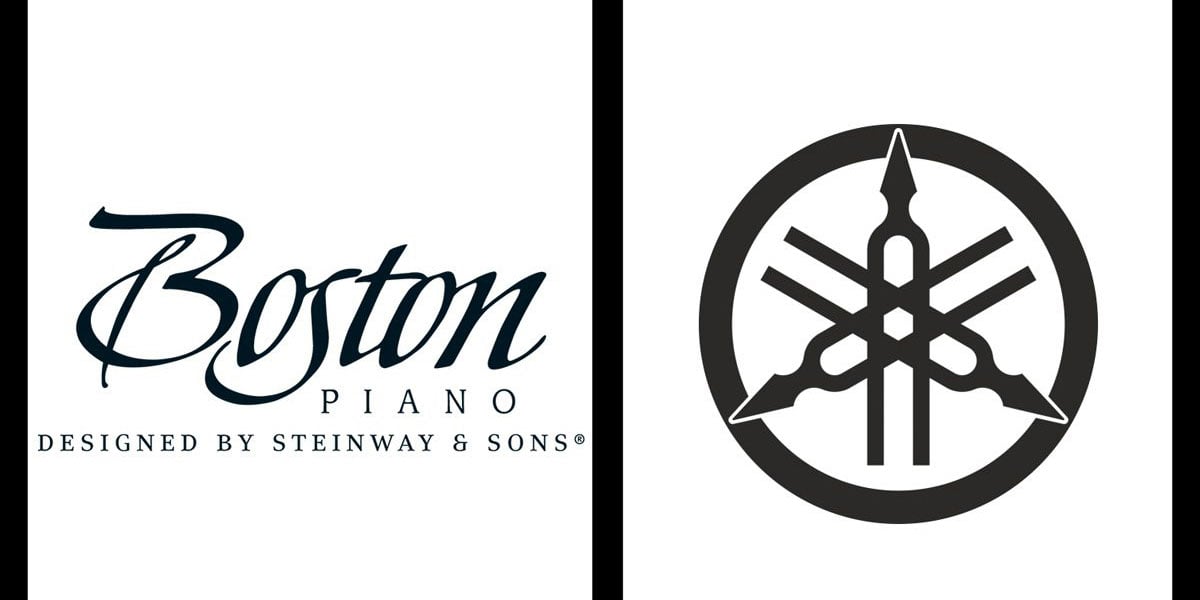
With several good options for buyers looking into new pianos today, making the best possible decision is important for a number of reasons. First, this is a serious investment, perhaps done only once in a lifetime. A well-built piano can easily outlast one generation in a family, becoming an heirloom for the next.
-
A purchase of this kind of importance and duration needs careful attention. Otherwise, you may purchase a piano that can become less a gift than a burden to give your children someday.
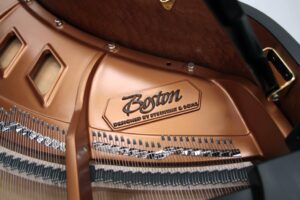 The Boston line was specifically designed to enable more piano buyers to obtain a piano with the Steinway design at a more affordable price.
The Boston line was specifically designed to enable more piano buyers to obtain a piano with the Steinway design at a more affordable price.
Will they inherit a treasured family instrument or a large piece of furniture nobody plays? Choosing the best instrument, one that brings out the best among those who play it, is key.
Since becoming a Steinway dealer in 1869, M. Steinert and Sons has been helping a range of customers discover the best piano for their needs. Since 1991, this has included offering the Boston line of mid-level grand and upright pianos.
The Boston line was specifically designed to enable more piano buyers to obtain a piano with the Steinway design at a price more affordable than a handcrafted Steinway.
Steinway has built a line of Boston pianos that has proven competitive in a market served by a range of piano brands, including Yamaha.
But which piano brand is better for you between Boston and Yamaha?
In this piece, we will take a look at the origins and strengths of Boston and Yamaha pianos, allowing you to learn more about both brands as you continue your journey towards buying a new piano.
Yamaha History and Production Design
-
Yamaha Piano History
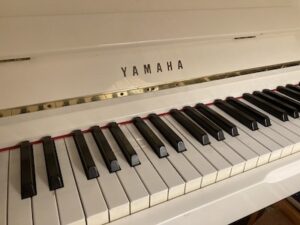 After Yamaha's founding in 1900, the company focused on manufacturing pianos for the Japanese market. Still, Yamaha had international aspirations.
After Yamaha's founding in 1900, the company focused on manufacturing pianos for the Japanese market. Still, Yamaha had international aspirations.
The first piano made in Japan was an upright built in 1900 by Torakusu Yamaha, founder of Nippon Gakki Co., Ltd. — later renamed Yamaha Corporation. Just two years later, the Nippon Gakki factory produced its first grand piano.
During this early period, the company focused on manufacturing instruments for the Japanese market. Still, Yamaha had international aspirations. Just as Henry Steinway had done with his pianos a generation before, Torakusu began to win international recognition soon after he founded Yamaha.
For example, Torakusu entered one of his pianos at the 1904 St. Louis World’s Fair, where it won an Honorary Grand Prize.
Yamaha learns Western piano production techniques
By the 1920s, Yamaha sent its craftspeople traveling overseas to understand the latest European piano production techniques. Yamaha’s piano production picked up again after the war years.
In 1950, Yamaha produced the FC concert grand piano. In 1956, the company completed work on Japan’s first computer-controlled artificial drying room. In 1958, Yamaha set up a grand piano assembly line at its headquarters in Hamamatsu.
Yamaha International is born
At the start of the 1960s, Yamaha made a significant investment, creating a new company in the U.S.A. to import and distribute its pianos: Yamaha International Corporation. By 1965, Yamaha was producing more pianos than any other manufacturer. By 1970, Yamaha’s manufacturing facilities had produced one million pianos.
Yamaha production details
Japanese manufacturing is known for its attention to detail and quality control. Like Steinway, Yamaha models go through a series of stringent quality control tests, from construction methods to wood selection.
- Yamaha uses spruce for its soundboards and uses other traditional piano parts including:
- Beech bridges
- Pine backposts
- White wood hammers
- Cast-iron frame
Yamaha’s range of production pianos offers a variety of results for the musician, from entry-level to conservatory-worthy. For grand pianos, these series are: GB1K/GC, CX, SX, and CF. Yamaha has even more upright series, which are: U, YUS, b, P22, and Gallery Collection.
Yamaha currently sells a mind-blurring number of grand and upright models: 32 of various kinds and different qualities.
Yamaha’s quality varies across their different series--and even within each series. For example, in the CX grand piano series, the CX7, CX6, CX5, and CX 3 models have spruce wood for their backposts, the CX2 and CX1 have Merkus pine.
Another example is in the composition of the keys across the different series. In the GB1K/GC series, you will find that the white keys are made of Acrypet (methacrylic resin), while the other Yamaha series use Ivorite for their white keys. Ivorite is Yamaha’s attempt to create plastic keys with the feel of ivory keys.
Not all Yamahas are created equal
The point is, although each model has the Yamaha name on its fallboard, not all Yamahas are created equal.
 An informed piano buyer will want to study the specifications of each Yamaha piano series as differences are not always obvious initially.
An informed piano buyer will want to study the specifications of each Yamaha piano series as differences are not always obvious initially.An informed piano buyer will want to study the specifications of each of their piano series as differences are not always obvious initially. The importance of materials cannot be overstated.
For example, Many Yamaha pianos, especially their lower-priced offerings, use softer woods and a higher-tension scale design. Consequently, these models are characterized by a considerably brighter tone.
This can be an appealing sound at first, especially for beginning pianists, but some find it limiting as you advance in your musical studies. M. Steinert & Sons often receives Yamaha vertical pianos in trade for Steinway and Boston grands.
Having said that, Yamaha has become the preferred model of some international music festivals as well as several jazz and contemporary pianists.
Boston piano history and design
Boston history
The Boston Piano Company was founded in 1991, a subsidiary of Steinway & Sons. Steinway wanted to capture the mid-level piano market that was growing internationally without having to compromise the Steinway & Sons approach to materials and craftsmanship.
Steinway designed the Boston and contracted with Kawai to develop a better, top-quality manufactured piano at a price lower than handcrafted Steinways.
Boston’s Steinway design
The Steinway elements present in the Boston
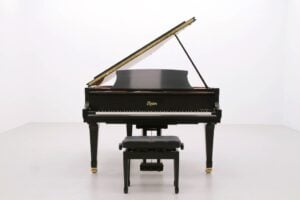 As a Steinway-designed piano, the Boston is characterized by a rich, even tone.
As a Steinway-designed piano, the Boston is characterized by a rich, even tone.Steinway engineers Susan Kenagy and John Patton designed the Boston from the ground up at Steinway & Sons’ New York factory, calling upon 165 years of piano manufacturing. Steinway-designed features used in the Boston include:<
- Low-tension scaling resulting in a longer sustaining tone
- More sustain, dynamic range, and warmer tones
- Sitka Spruce soundboard, providing a bigger, fuller tone
- Hard Rock Maple inner rim, producing less vibration and less absorption of sound
- Wide-tail design for bigger sound
- Solid copper-wound bass strings, ensuring pure tone for the life of the instrument.
Boston and the Performance Editions
Boston pianos have all parts assembled manually. Boston’s design roots can be traced back to 1836 with the creation of the first Steinway in Germany and subsequently in New York in 1853.
Everything that Steinway knows about pianos from their long experience is considered in the design of the Boston—musicality, longevity, durability, and future residual value.
In 2009, 18 years after the launch of Boston in 1991, Boston's first Performance Edition model was rolled out.
This first Performance Edition included a maple inner rim and the patented Octagrip pin block, which gives the Boston a smoother pin turn and more consistent pin torque. This allows for more precise tuning.
Boston’s Performance Edition II rolled out in 2016, added several upgrades. The Performance Edition II features a luxurious Pomelle Sapele veneer on the inside rim of Ebony finish grands and a rose-gold colored plate.
Black felts have been added for the plate, under the fallboard, and around the pedals. A rescaled bass and treble wire lower string tension provides increased sustain, better tone clarity generally, and a deeper, clearer bass.
Boston has picked up endorsements
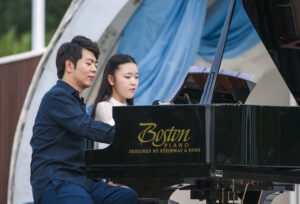 Steinway Artist Lang Lang performing on a Boston grand.
Steinway Artist Lang Lang performing on a Boston grand.Steinway and Boston’s even tone has been endorsed for pianists across musical genres. Indeed, the company’s rosters of piano greats, Steinway Artists and Steinway Immortals, have always been well-represented by famous jazz and contemporary pianists.
Just 30 years on the market, Boston has become the preferred piano brand of several musical groups. The American Piano Quartet, The Gryphon Trio, and The Mendelssohn Choir of Pittsburgh use Boston pianos.
The Boston line includes five grand pianos and five upright models, along with Steinway’s hybrid Spirio self-playing piano.
The tone of the two pianos
Yamaha’s bright tone liked by some performers in modern musical genres
Yamaha has learned how to incorporate Western expectations into their pianos and has sold many over the years. Still, the fully-manufactured Yamahas have a bright, clear tone.
While this makes them less preferred among most of the world’s professional concert pianists, that kind of tone has been better received by some jazz pianists like the late Chick Corea.
One area Yamaha and Boston have in common is in their power. Both Yamahas and Boston project well, especially in concert auditoriums.
Steinway DNA in Boston pianos produce an even, well-rounded tone
As detailed above, Boston has inherited much of the Steinway design or DNA. What does it mean for a piano to have Steinway design?
-
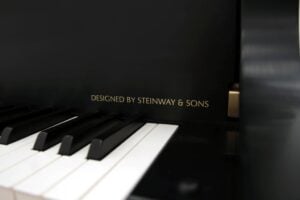 Steinway-designed pianos like Boston have a subtlety to them that allows the pianist to achieve color changes and new dynamics exactly what the artist asks of it.
Steinway-designed pianos like Boston have a subtlety to them that allows the pianist to achieve color changes and new dynamics exactly what the artist asks of it.
Statistically, it is well-documented that over 95% of concert pianists worldwide performing with major symphony orchestras choose to play on Steinway pianos and are not remunerated by Steinway for their preference.
Steinway-designed pianos like Boston have a subtlety to them that allows the pianist to achieve color changes and new dynamics exactly what the artist asks of it.
In addition to this nuanced range of color and dynamics, Boston, like Steinway, has an even and well-rounded tone.
Boston’s tone has been endorsed for pianists across musical genres. As part of the Steinway family of pianos, Boston takes pride in the rosters of piano greats, Steinway Artists and Steinway Immortals. Both lists have always been well-represented by famous jazz and contemporary pianists from George Gershwin to Aaron Diehl.
Re-capping main differences between Boston and Yamaha
| Boston | Yamaha |
|---|---|
Even, well-rounded tone |
Bright, clear tone |
Low tension scale design |
High tension scale design |
10 models - a single quality standard |
32 models - varying quality standards |
Pricing
Larry Fine’s website at pianobuyer.com is a widely used source for piano information. Under Brand Profiles for Yamaha, he distinguishes between what typical Yamaha dealers LIST their pianos at (MSRP) and what they should actually sell for if priced fairly (SMP).
Under the Brand Profile for Boston, the MSRP and the SMP are identical--in other words, Boston piano prices are not inflated by Steinway dealers and then discounted to a fair selling price.
Which piano is best for you?
The best way to decide on a new piano is to play some models for yourself. Whether tone, design, or price is most important to you, an informed piano buyer will get a feel for different models and brands.
At M. Steinert & Sons, our seasoned piano consultants will listen well to your priorities for this important purchase. Some of our piano consultants have worked for both Yamaha and Steinway dealers, allowing them to fairly present the better attributes of these two legendary piano makers.
So while we naturally feel that the Boston is the better piano for many people, we acknowledge that Yamaha has produced some good models, as well. What is most important is that you find the best piano for you.
Please consider a visit to one of our showrooms in Boston or Newton. Meantime, continuing reading some additional pieces below:
How the pandemic brought life back to our living rooms
How to choose the right piano for me?
Featured Articles
Categories
- Beginner Pianos (18)
- Boston Pianos (12)
- Comparisons (26)
- Designer and Specialty Pianos (8)
- Essex Pianos (10)
- Events (11)
- Featured (21)
- Institutional (3)
- Joy of Piano (12)
- Learning About Pianos (62)
- News (34)
- Piano Bits (6)
- Pricing and Cost (19)
- Resource Center (116)
- Roland Pianos (6)
- Spirio (13)
- Steinway Pianos (64)
- Student (14)
- Teacher (12)
- Used Pianos (20)
- Videos (13)

